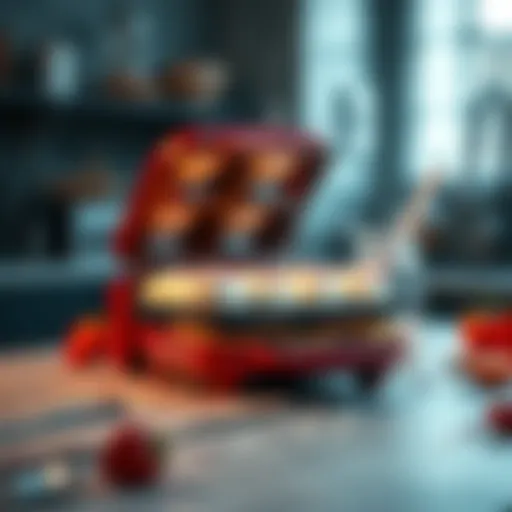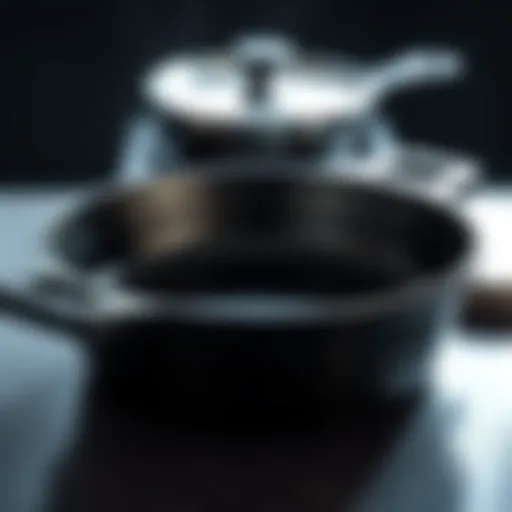Deliciously Simple Banana Pudding Recipes
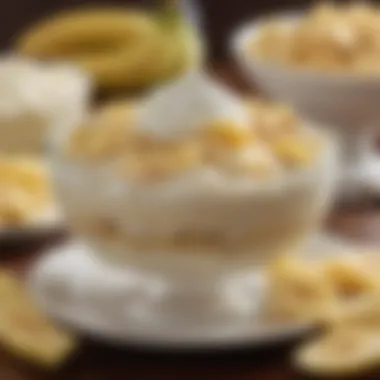

Ingredients Breakdown
When delving into banana pudding, an understanding of ingredients is essential. This classic dessert often brings comfort and joy to many, and creating it starts with selecting the right components.
Primary Ingredients
The fundamental ingredients for a basic banana pudding recipe include:
- Ripe Bananas: The star of the dish. Their natural sweetness and softness make them ideal for layering.
- Vanilla Pudding: This serves as the creamy base. You can opt for a store-bought package or prepare it from scratch using milk and sugar.
- Vanilla Wafers: Crispy and sweet, these provide a delightful texture and complement the soft pudding and bananas.
- Whipped Cream: For that frosting touch, adding light and fluffy whipped cream enhances the dessert experience.
Optional Ingredients
While the primary components are vital, some optional ingredients can elevate the flavor:
- Peanut Butter: Mixing in peanut butter can add a rich, nutty taste to the pudding.
- Chocolate Chips: For chocolate lovers, incorporating chocolate can create a delightful layer of flavor.
- Nutmeg or Cinnamon: A pinch of these spices adds warmth and extra depth.
Essential Kitchen Tools
To create your banana pudding effectively, having the right tools is crucial:
- Mixing Bowls: Necessary for combining ingredients easily.
- Spatula: Useful for folding in whipped cream without losing volume.
- Serving Dishes: Choose clear glass bowls or trifle dishes to showcase the layers of the pudding.
Step-by-Step Preparation
Preparation is key in ensuring your banana pudding turns out delicious and visually appealing.
Prepping the Ingredients
Start by gathering your ingredients. Slice the ripe bananas evenly to promote aesthetic layers. If you use homemade vanilla pudding, prepare it in advance, allowing it to cool before assembly.
Cooking Techniques and Methods
- Prepare the Vanilla Pudding: Follow the instructions on the package or use a homemade method. The pudding should be smooth and free of lumps.
- Whip the Cream: Use chilled cream for best results. Beat until soft peaks form. This adds airiness, improving the overall texture.
Assembly and Presentation Tips
Layering is essential in banana pudding. Begin with a layer of vanilla wafers, followed by a layer of bananas, and then a thicker layer of pudding. Alternate these layers until you reach the top of the dish. Top with whipped cream and consider garnishing with banana slices or wafer crumbles for an appealing look.
Dietary Considerations
In today’s diverse culinary landscape, it is imperative to accommodate various dietary needs when preparing banana pudding.
Gluten-Free Options
For those with gluten sensitivities, use gluten-free vanilla wafers. Always check labels to ensure they meet gluten-free standards.
Vegetarian and Vegan Substitutes
To create a vegan version of banana pudding:
- Replace dairy milk with almond or coconut milk.
- Use vegan whipped cream alternatives.
- For pudding, look for plant-based mixes or make a simple recipe using cornstarch, almond milk, and agave syrup.
Nutrition Facts & Nutritional Considerations
When preparing your banana pudding, consider the nutritional impacts of your ingredients. Bananas are rich in potassium, while the pudding and cream add calories and sugar. Mindful moderation can ensure enjoyment without overindulgence.
Variations and Customizations
One of the delightful aspects of banana pudding is its versatility. There are numerous ways to customize this dessert according to personal preferences.
Flavor Enhancements
Experiment with different flavors by adding:
- Almond Extract: A drop can amplify the overall flavor profile.
- Caramel Drizzle: Drizzling caramel sauce on top provides a sweet contrast.
Alternative Cooking Methods
Consider preparing banana pudding in different styles:
- No-Bake Version: This method bypasses any cooking by using instant pudding mix, keeping preparation quick and simple.
- Baked Banana Pudding: Some recipes call for baking, which alters the texture of the pudding considerably.
Pairing Suggestions (Sides, Drinks, etc.)
Banana pudding pairs beautifully with beverages like sweet tea or coffee. Additionally, serve it alongside fresh fruit salads or light cookies to create a well-rounded dessert table.
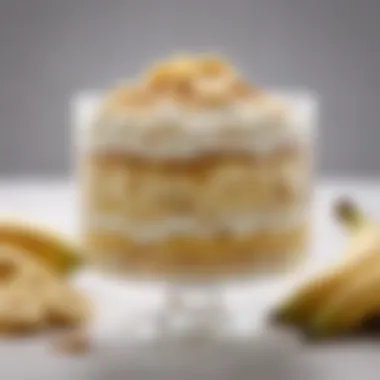

Common Answers to Common Questionss and Troubleshooting
Finally, addressing common inquiries can aid in the successful preparation of banana pudding.
Frequently Asked Questions
- Can I use frozen bananas?
Frozen bananas can be used, but it may alter the texture, making it mushy. - How long does banana pudding last?
Generally, it stays fresh in the refrigerator for about 3-4 days.
Common Mistakes to Avoid
Some pitfalls could ruin your dish:
- Using Under-Ripe Bananas: They may not provide the sweetness needed.
- Not Chilling the Pudding Enough: Ensure pudding is adequately chilled before layering to avoid mixing the layers.
Solutions to Potential Problems
In case of a runny pudding, consider cooking it slightly longer or adding more cornstarch. For overly sweet pudding, adjusting the sugar in the recipe can help balance flavors.
A little bit of troubleshooting goes a long way in crafting the perfect banana pudding.
Intro to Banana Pudding
Banana pudding is more than just a dessert; it is a nostalgic dish that holds a special place in many hearts. This article aims to explore the essence of banana pudding, emphasizing its significance in the world of culinary delights. Understanding the basics of banana pudding provides a foundation for anyone looking to dive into its preparation, whether for personal enjoyment or to impress guests.
One important element to consider is that banana pudding has versatile applications. It can serve as a comforting treat or a sensational finale to a meal. This adaptability speaks to its ability to cater to various occasions and preferences. Moreover, banana pudding is also a great canvas for creativity. Ingredients can be adjusted according to personal taste or dietary needs.
Additionally, there are considerations when making banana pudding. Selecting the right ingredients can make a significant difference. While it may seem straightforward, the choice of bananas and pudding type has a big impact on flavor and texture. This section sets the stage for understanding how historical context and cultural significance shape the way people enjoy banana pudding today.
Historical Context
The origins of banana pudding can be traced back to the United States, particularly in the southern regions. Its history reflects a blend of different culinary influences over time. Traditional recipes often included layers of vanilla pudding, wafer cookies, and sliced bananas, creating a balanced interplay of creaminess and freshness.
Many food experts point out that banana pudding gained popularity in the early 20th century. It became a staple during the Great Depression, as it was both economical and satisfying. The use of simple, accessible ingredients allows families to create a delicious dessert without breaking the bank. This accessibility helped put banana pudding on many family tables, solidifying its status as a beloved comfort food.
Cultural Significance
Banana pudding transcends its role as merely a sweet treat. It embodies cultural values of hospitality and sharing, especially in southern traditions. Households often serve banana pudding at gatherings, big meals, and celebrations. Each spoonful carries memories and stories of togetherness.
Furthermore, modern adaptations reflect ongoing cultural shifts. People experiment with flavors and dietary restrictions, such as vegan or gluten-free options. This shows that banana pudding continues to evolve while staying true to its roots. Its adaptability contributes to its lasting nature in today's diverse culinary landscape.
Banana pudding is not merely about taste; it encompasses history, culture, and community. This foundation fosters an appreciation for the dish as one learns to prepare it. As the reader delves deeper into this article, they will discover essential ingredients, preparation techniques, and various delightful variations.
Essential Ingredients in Banana Pudding
When it comes to making banana pudding, the ingredients play a crucial role in both flavor and texture. Selecting high-quality components is vital to achieving a delicious and satisfying dessert. Each ingredient contributes to the overall experience, making the pudding enjoyable for everyone. This section will delve into the importance of the essential ingredients in banana pudding, paying close attention to their characteristics and contributions to the dish.
Bananas: Selecting the Right Variety
The bananas you choose are fundamental to the quality of banana pudding.
Generally, ripe, sweet bananas work best in this dessert. Look for those that are firm but have a few brown specks on the skin. This indicates ripeness without excessive mushiness. Cavendish bananas are the most commonly used type in banana pudding, known for their sweetness and availability. However, you may also experiment with other varieties like red bananas or plantains for a different flavor profile. Selecting fresh, high-quality bananas improves not only the flavor but also the texture, ensuring a pleasant experience.
Pudding Base: Homemade vs. Store-Bought
The choice between homemade and store-bought pudding can significantly affect the final dish. Homemade pudding allows you to control the flavor and sweetness, as well as avoid preservatives. Generally, a creamy custard base made from scratch can enhance the richness of your banana pudding.
However, convenience is a key factor. Many opt for store-bought pudding, which saves preparation time. It’s essential to read the labels, as not all store-bought options are created equal. Choose a high-quality product with limited additives. Some reputable brands like Jell-O or Royal provide delightful pudding mixes. Balancing convenience and quality will elevate your banana pudding.
Additional Flavors and Textures
While bananas and pudding are the core components, adding additional flavors and textures can make the dessert even more appealing. Common choices include vanilla wafers, whipped cream, and chocolate.
- Vanilla Wafers: These cookies add a delightful crunch that contrasts the creaminess of the pudding and bananas.
- Whipped Cream: A dollop of whipped cream on top can enhance the flavor and give it a light, airy quality.
- Chocolate: Incorporating chocolate—whether through chocolate wafers or cocoa powder—brings a rich, indulgent taste.
Experimenting with these additional elements can create a personalized banana pudding that caters to diverse palates. The right combinations can transform a standard banana pudding into a culinary creation worthy of any gathering.
By carefully selecting ingredients, home cooks can craft a banana pudding that satisfies even the most discerning tastebuds.
The Basic Preparation Method
Understanding the basic preparation method for banana pudding is crucial for mastering this delightful dessert. Good preparation forms the backbone of a successful recipe. Without a solid base, the texture and flavor may fall short of expectations, thereby detracting from the overall experience.
Executing the preparation steps with precision not only affects taste but also enhances presentation. Layering ingredients correctly, whisking the pudding base to the right consistency, and properly arranging layers can lead to a beautifully crafted treat. Furthermore, a well-prepared pudding exudes professionalism, which is key when serving to friends or family. Given the simplicity of the steps involved, anyone can become proficient in making banana pudding quickly.
Step-by-Step Instructions
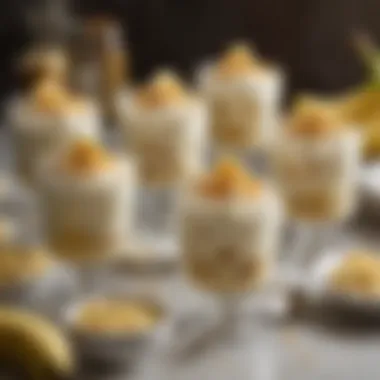

Creating banana pudding is not overly complicated, but attention to detail is needed at each step. Here is a clear breakdown of how to make it:
- Gather Ingredients: You will need ripe bananas, pudding mix, milk, vanilla wafer cookies, and optional toppings like whipped cream or nuts.
- Prepare the Pudding Base: In a bowl, combine the pudding mix with milk. Whisk the mixture until smooth, ensuring there are no lumps.
- Slice the Bananas: Cut the bananas into even slices to ensure they layer well.
- Layer the Ingredients: Start with a layer of vanilla wafers, followed by a layer of banana slices, then pour some pudding over. Repeat this until you reach the top of your dish.
- Chill: Cover the dish with plastic wrap and place it in the refrigerator for at least four hours, allowing the flavors to meld.
- Serve: Once chilled, you may add whipped cream or other toppings before serving.
These steps provide a simple and effective method to enjoy banana pudding with minimum effort, ensuring great taste.
Tips for Optimal Consistency
Achieving the right consistency in your banana pudding is essential to its texture. Here are important tips to ensure you get it right:
- Use Ripe Bananas: They should be at the right ripeness. Too firm, and they may not blend well. Too ripe, and they may turn mushy too quickly.
- Proper Mixing of Pudding: When combining the pudding mix with milk, make sure to whisk vigorously but gently to avoid bubbles. This keeps the pudding smooth and creamy.
- Chill Time: Don’t rush the chilling process. Allowing the pudding to sit in the fridge helps it set correctly, resulting in a thicker and creamier texture.
- Avoid Overmixing: Once you combine the pudding with banana and wafers, gently fold the mixture instead of stirring heavily.
Following these recommendations guarantees that your banana pudding will have a satisfying texture, enhancing both the visual appeal and flavor of the dish.
Remember, preparation is key. Paying attention to each tiny detail encourages an impressive final product that will be enjoyed by all.
Variations of Banana Pudding
Exploring the concept of variations in banana pudding is essential for any home cook. Variations can offer new flavors, textures, and overall experiences while still remaining true to the essence of this classic dessert. By experimenting with different ingredients and methods, one can cater to diverse preferences and dietary requirements. This not only enhances personal enjoyment but also allows for creative expression in the kitchen.
Chocolate Banana Pudding
Chocolate banana pudding is a delightful twist on the traditional recipe. The richness of chocolate combines well with the sweetness of bananas, creating a harmonious blend of flavors. To prepare it, follow these key steps:
- Start with the Base: Use a basic banana pudding recipe as your foundation.
- Incorporate Chocolate: Add cocoa powder or melted chocolate to the pudding mix. Adjust the amount according to your taste preference; typically, one-third cup of cocoa powder should suffice.
- Layering: Alternately layer chocolate custard with sliced bananas in a serving dish, creating an appealing contrast of colors.
- Serve Cold: Once assembled, allow it to chill for several hours for the flavors to meld properly.
This variation not only satisfies chocolate lovers but also adds depth to the classic dish without overly complicating the preparation process. It is well-appreciated for gatherings or as a comforting dessert.
Vegan Banana Pudding Alternatives
For those who prefer a plant-based diet, vegan banana pudding alternatives can be equally satisfying. Using dairy-free ingredients, this version ensures that everyone can enjoy the creamy goodness of banana pudding. Here’s how to make it:
- Plant-Based Milk: Substitute traditional milk with almond, coconut, or oat milk.
- Thickening Agents: Use cornstarch or arrowroot starch to achieve the creamy texture. This step is crucial as it forms the base of the pudding.
- Sweeteners: Maple syrup or agave nectar can replace sugar. These options not only provide sweetness but also add unique flavor profiles.
- Flavor Enhancers: Incorporate vanilla extract for a richer taste.
To maintain the required consistency, allow the mixture to simmer until it thickens adequately. Let it cool before layering with bananas and vegan whipped cream. This approach effectively caters to those following a vegan lifestyle, ensuring they don’t miss out on a beloved dessert.
Gluten-Free Options
Different people have various dietary needs, and understanding gluten-free adaptations of banana pudding can be beneficial. This variation remains faithful to the original dessert’s flavors while being accessible to individuals with gluten intolerance or celiac disease. Here are some guidelines:
- Gluten-Free Starches: Utilize cornstarch or arrowroot starch as thickeners instead of regular flour. They are excellent choices for achieving the desired consistency without gluten.
- Choose Gluten-Free Cookies: If you plan to add cookies as layers, select those specifically labeled as gluten-free. Many brands offer cookies designed to be suitable for gluten-sensitive diets.
- Flavoring with Care: Always check the ingredient labels of any additives to ensure they are gluten-free. This includes vanilla extracts and other flavoring agents.
By observing these adaptations, you can confidently prepare banana pudding that everyone can enjoy, without worrying about gluten complications. This sharing of recipes can enhance the joy of dessert for all, regardless of dietary restrictions.
Serving Suggestions
Serving suggestions play a significant role in the culinary experience of banana pudding. This dessert can be perceived not just as a delightful combination of flavors but also as a reflection of creativity in presentation and complementary pairing with other dishes. How we serve banana pudding can elevate its appeal, enhance its taste, and create a more enjoyable experience for those who savor it.
Presentation Techniques
The appearance of banana pudding can greatly influence first impressions. A well-presented dish entices the senses, prompting anticipation before the first bite. Here are some techniques to enhance the visual appeal of banana pudding:
- Layering: Create distinct layers of pudding, bananas, and cookies in a glass or a trifle bowl. This not only showcases the ingredients but also adds texture.
- Garnishing: Fresh mint leaves or chocolate shavings can provide a dash of color and sophistication. A light dusting of cocoa powder can also make each serving more alluring.
- Serving Portions: Individual servings in small jars or cups can make a more personalized experience. This method also aids in portion control, which is beneficial for those mindful of their intake.
Pairing with Other Dishes
The simplicity of banana pudding allows it to complement various dishes perfectly. Here are a few ideal pairings:
- Light Salads: A crisp salad with vinaigrette dressing balances the richness of banana pudding, offering a refreshing contrast.
- Barbecued Meats: The sweet nature of the pudding can cut through the savory flavors of grilled or smoky meats, making them a delightful combination.
- Coffee or Tea: A cup of coffee can serve as a bitter counterpart to the sweet dessert, while tea can provide a soothing end to a meal.
- Fruit Platters: Complementing banana pudding with a variety of fresh fruits adds a refreshing element and can enhance the overall taste experience.
A harmonious breakfast or brunch further enhances the enjoyment of banana pudding. By adding a cohere of flavors through smart pairing, one can elevate this classic dessert into a versatile dish appreciated by many.
Common Mistakes to Avoid
When creating banana pudding, attention to detail is essential. Mistakes may seem trivial, but they can significantly affect the final product. Identifying common pitfalls helps cooks of all skill levels improve their results. This section explores two typical mistakes in banana pudding preparation: using bananas that are not ripe enough or too ripe, and incorrectly timing the pudding cooking process. Understanding these factors can lead to a more satisfying dessert experience.
Under-ripening or Over-ripening Bananas
Selecting the right bananas is crucial for banana pudding. Under-ripe bananas tend to be starchy, which can create an unpleasant texture. Their lack of sweetness also results in a bland pudding. Conversely, overripe bananas might be too soft and mushy, leading to a pudding that lacks structure. To determine the perfect ripeness, look for bananas that are mostly yellow with a few brown spots. These spots indicate the fruit is sweet and soft enough while maintaining some firmness for the pudding.
In terms of flavor, ripe bananas provide a more intense taste, enriching the pudding's overall profile. This is important because the bananas should complement the creaminess of the pudding base. Avoid both extremes to ensure a delightful mouthfeel and flavor.
Incorrect Pudding Timing
Timing plays a critical role in the preparation of banana pudding. Many home cooks do not pay enough attention to the cooking and cooling process. Overcooking the pudding can lead to curdling, resulting in a grainy texture. It is important to monitor the mixture closely, stirring constantly to prevent scorching on the bottom of the pot. Remove the pudding from heat promptly once it reaches the desired consistency.
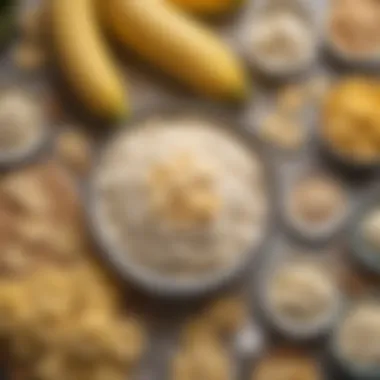

Additionally, allow the pudding to cool properly before assembling. If you layer the bananas with warm pudding, they might become soggy and lose their freshness. Conversely, if the pudding cools too long, it may set too firmly, making it challenging to work with. A simple tip is to let the pudding sit at room temperature for about 30 minutes before refrigerating it, ensuring optimal texture and flavor when assembled.
Key Takeaway: Paying attention to banana ripeness and cooking timing can often make the difference between a mediocre pudding and a delectable dessert.
Culinary Techniques for Advanced Preparation
Culinary techniques play a pivotal role in optimizing the experience of making banana pudding. Through the application of various methods, home cooks can elevate a straightforward recipe into a culinary delight. This section will explore the significance of these techniques, along with detailed guidance on incorporating them effectively.
Incorporating Culinary Techniques
Advanced culinary techniques can enhance the texture and flavor of banana pudding. One method to consider is the temperature control. Working with ingredients at their optimal temperature can greatly influence the outcome. For instance, using cold ingredients can help achieve a lighter, fluffier pudding. Another key technique is layering. Strategically layering bananas, pudding, and wafers can create visual appeal and a balanced flavor profile. This process allows for an even distribution of flavors throughout the dish.
Another valuable technique is tempering. When adding eggs to make a custard base, it’s important to temper them. Gradually introducing warm liquid to the eggs prevents them from scrambling. This careful method helps achieve a smooth and creamy pudding. Moreover, consider hand-whisking rather than using a machine. Hand-whisking can yield a finer, more delicate texture that is pleasing to the palate. Ultimately, the choice of technique can determine the pudding's quality and overall enjoyment.
Garnishes and Finishing Touches
Garnishes elevate the visual appeal of banana pudding while also adding nuance to its flavor. Simple garnishes like whipped cream are classic and serve to heighten the dessert's indulgence. Consider using toasted coconut flakes or chocolate shavings as well, which can introduce delightful texture and flavor contrasts. Chocolate curls create an air of sophistication, appealing to a wide range of dessert lovers.
Do not overlook the significance of fresh fruit as a garnish. Slices of banana placed on top not only communicate what is within but also enhance freshness. Additionally, a drizzle of caramel sauce or a sprinkle of cinnamon can offer surprising twists that elevate the dish entirely.
By taking the time to use effective culinary techniques and thoughtful garnishing, you can transform even the simplest banana pudding into a masterpiece.
In summary, the application of advanced culinary techniques, combined with creative garnishes, can significantly enhance the quality of banana pudding. With these strategies, home cooks can achieve flavors and textures that resonate well with both themselves and their guests.
Nutritional Considerations
Understanding the nutritional aspects of banana pudding will help you create a dessert that not only delights the palate but also fits within your dietary preferences or restrictions. Banana pudding, while delicious, can have varied health implications based on ingredients and serving sizes. This section will explore the caloric content of pudding and suggest healthier substitutions to cater to different diets.
Caloric Content and Serving Size
The caloric content in banana pudding typically varies based on the ingredients used. A standard serving of traditional banana pudding can range from 200 to 400 calories. Some factors influencing these numbers include the type of pudding mix or base, the quantity of sugar added, and the presence of heavy cream versus lighter alternatives. Being aware of how these components contribute to the overall caloric count is crucial for those managing their daily intake.
When preparing banana pudding, it's important to consider portion sizes, especially if you are serving a large group. Here are some important points:
- Standard Serving Size: A common serving is usually around half a cup, but many people may consume more without realizing it.
- Caloric Breakdown: If using instant pudding mix and full-fat milk, the number of calories can add up quickly.
- Portion Control: Keeping servings in check helps in enjoying the dessert without overindulgence.
"Mindful consumption of desserts like banana pudding can allow for enjoyment without detriment to one's health goals."
Understanding the caloric impact helps you make informed choices during preparation.
Healthy Ingredient Substitutions
Incorporating healthier ingredients can enhance the nutritional profile of banana pudding, enabling it to be a fitting choice for those following specific dietary guidelines. Here are some substitutions to consider:
- Greek Yogurt Instead of Whipped Cream: Using Greek yogurt not only reduces calories but also adds protein, making the dessert more satisfying.
- Almond Milk in Place of Whole Milk: Almond or other plant-based milks can significantly lower calories and saturated fats, appealing to vegan or lactose-intolerant individuals.
- Natural Sweeteners Over Refined Sugar: Consider using honey or agave syrup as alternatives to white sugar. They offer sweetness with additional nutrients.
- Whole Wheat Cookies Instead of Regular: If adding layers of cookies, look for whole wheat options. They provide fiber and can improve digestion.
These substitutions can transform traditional recipes into healthier versions that still maintain the essence of banana pudding. Balancing taste and nutrition is possible and can meet the needs of health-conscious individuals.
Storing and Reheating Banana Pudding
Banana pudding is a delightful treat that is as versatile in its serving options as it is in its flavor combinations. However, once you’ve prepared this creamy dessert, understanding the best ways to store and reheat it ensures that every bite maintains its intended texture and flavor. Proper storage not only prolongs the shelf life of the pudding but also prevents issues like browning bananas and sour cream texture. Likewise, knowing how to reheat your banana pudding can reintroduce that fresh-out-of-the-kitchen quality.
Best Practices for Storage
When it comes to storing banana pudding, a few simple practices can help maintain its quality:
- Use Airtight Containers: Choose containers that seal tightly. This prevents air exposure, which can lead to spoilage.
- Refrigerate Promptly: After making banana pudding, let it cool if it's warm, but do not leave it out for more than two hours. Once cooled, refrigerate it to keep it safe.
- Layer Wisely: If using sliced bananas in the pudding, consider placing a layer of plastic wrap directly on the surface. This can help prevent browning caused by air exposure.
- Avoid Storing Long-Term: For best results, consume your banana pudding within three to four days. Beyond this duration, both the texture and flavor may deteriorate significantly.
- Freeze with Caution: Freezing banana pudding is generally not recommended due to the potential for texture changes. If you must freeze it, do so without the bananas and add them after thawing.
Reheating Techniques
If you have made banana pudding ahead of time and need to reheat it, consider these techniques:
- Gentle Microwave Heating: Use a microwave-safe bowl and cover loosely. Heat on low for short intervals, stirring occasionally. This method helps to warm it without cooking the ingredients further.
- Stovetop Method: For a more controlled approach, transfer the pudding into a saucepan. Heat on low, stirring continuously until it’s warm. This prevents any scorching and keeps the pudding smooth.
- Avoid Overheating: Be cautious when reheating as overheating can change the texture, leading to curdling or burning.
Always taste before serving after reheating. If needed, you can adjust sweetness or texture by adding a touch of milk or cream.
By applying these practices, you can extend the life of your homemade banana pudding while ensuring it remains enjoyable. Proper care in storage and reheating plays a crucial role in preserving the dish's characteristic creaminess and flavor.
The End: Mastering Banana Pudding
In summarizing the journey through the delightful craft of banana pudding, the importance of mastering this dessert becomes evident. This iconic dish is not just a sweet treat; it embodies a blend of flavors, textures, and nostalgic memories. Understanding the methods and ingredients allows home cooks to recreate their favorite childhood memories or to explore new culinary frontiers.
Moreover, this article has provided insight into various preparation techniques, ingredient selections, and serving suggestions that can elevate a simple pudding into an exceptional dessert. By following best practices and being aware of common pitfalls, one can enhance the overall experience of making and enjoying banana pudding. Whether serving guests at a gathering or savoring a personal serving, the satisfaction of creating this dish is unparalleled.
Recap of Key Takeaways
- Essential Ingredients: The selection of ripe bananas, quality pudding, and optional flavor enhancers are critical.
- Preparation Techniques: Sequential steps and cooking times significantly affect texture and flavor.
- Storage and Reheating: Proper techniques can preserve the pudding's quality, ensuring tasty results even after a few days.
- Variations: Many enjoyable adaptations exist, such as chocolate or vegan alternatives, catering to diverse preferences.
Encouragement for Culinary Exploration
The beauty of banana pudding lies in its versatility. Experimenting with different variations encourages creativity in the kitchen. Home cooks are urged to mix unique flavors or ingredients that resonate with personal preferences. Trying new garnishes, exploring different types of creams, or pairing the pudding with complementary desserts can lead to delightful surprises.
Ultimately, the art of banana pudding is not solely about following a recipe; it is a canvas for those willing to take culinary risks and innovate. Each individual has the opportunity to leave their mark on this classic dish. Engage in the process and remember that delicious food is as much about enjoyment as it is about technique.

